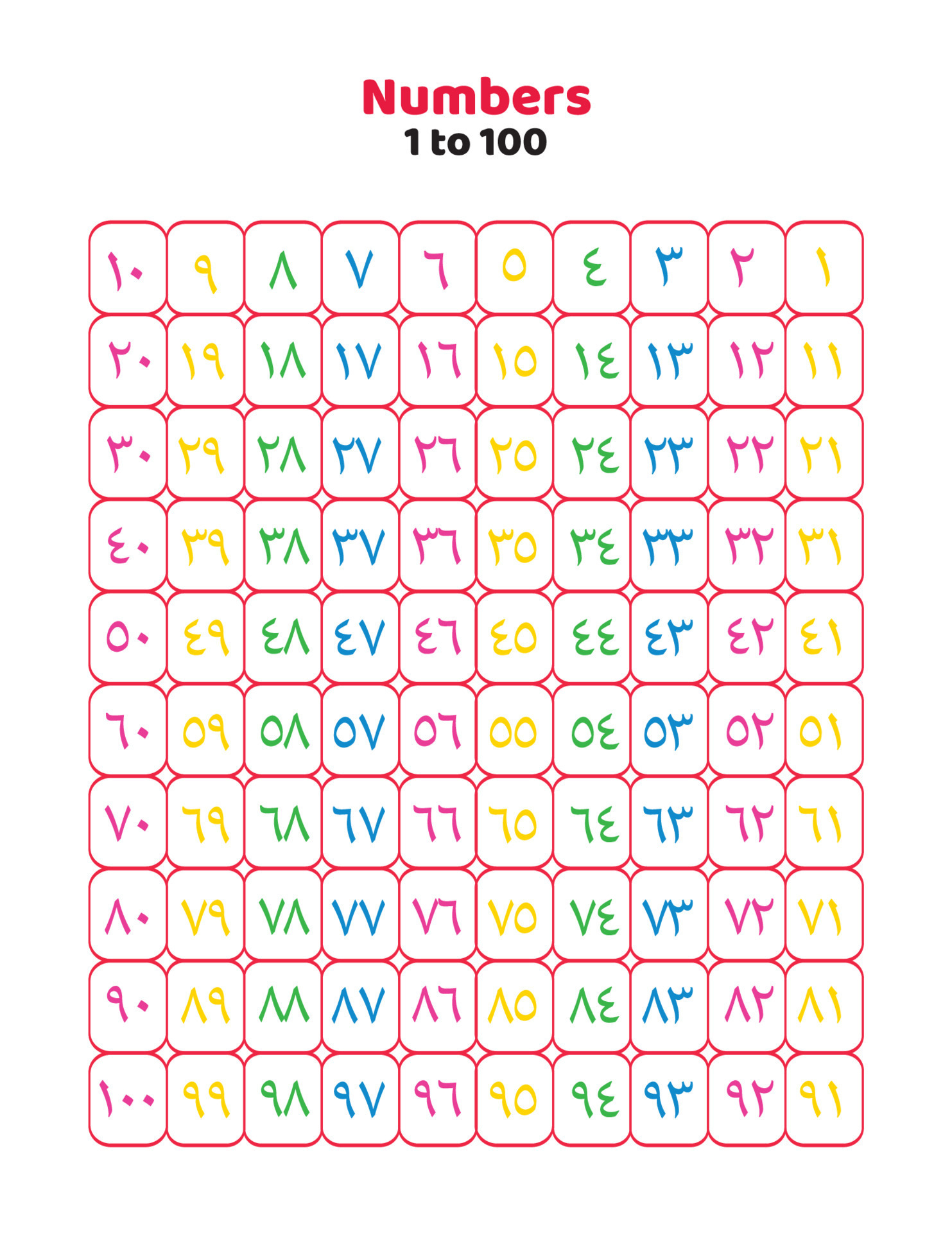Imagine yourself wandering through a bustling marketplace in the heart of the Middle East. The vibrant colors, the enticing aromas, the lively chatter all create an unforgettable sensory experience. But amidst the whirlwind of sights and sounds, something else grabs your attention: the numbers. Not the familiar digits we use, but a graceful script of Arabic numerals woven into the fabric of daily life. In this fascinating world, counting isn’t just about quantity; it embodies a rich cultural heritage and a powerful connection to the past. Ready to unlock this captivating realm of Arabic numerals? Join us as we embark on a journey to learn the Arabic words for numbers 1-100, exploring their history, significance, and the beauty of the Arabic language.

Image: islamkids.net
Numbers are more than just symbols; they are the building blocks of our understanding of the world. From the simplest transactions to intricate scientific formulas, numbers play a crucial role in our daily lives. But beyond their practical applications, numbers also hold cultural and historical significance. Within the Arabic language, each number boasts a unique identity, a melodic rhythm, and a story to tell. Learning these numerals unveils a portal to a world of cultural understanding, allowing us to connect with the rich history and vibrant tapestry of the Arabic-speaking world.
Unpacking the Arabic Numerals: From One to Ten
Let’s begin our journey by familiarizing ourselves with the Arabic words for the numbers one to ten. These foundational numbers form the building blocks for larger numerals and are essential for understanding the logic behind the Arabic number system.
Here they are:
- One: Wahid (واحد)
- Two: Ithnan (اثنان)
- Three: Thalatha (ثلاثة)
- Four: Arba’a (أربعة)
- Five: Khamsa (خمسة)
- Six: Sitta (ستة)
- Seven: Sab’a (سبعة)
- Eight: Thamāniyah (ثمانية)
- Nine: Tisa’a (تسعة)
- Ten: ‘Ashara (عشرة)
Notice the elegant flow of the Arabic words, each one carrying a distinct cadence. These words, often pronounced with a gentle inflection, reflect the beauty and musicality inherent in the Arabic language.
Building Upon the Foundation: Numbers 11-20
As we venture beyond ten, the Arabic numerals unveil their clever structure, building upon the foundational numbers we’ve already learned. Let’s delve into the Arabic words for numbers eleven to twenty:
- Eleven: Ahad ‘Ashara (أحد عشر) – “One and ten”
- Twelve: Ithnan ‘Ashara (اثنان عشر) – “Two and ten”
- Thirteen: Thalatha ‘Ashara (ثلاثة عشر) – “Three and ten”
- Fourteen: Arba’a ‘Ashara (أربعة عشر) – “Four and ten”
- Fifteen: Khamsa ‘Ashara (خمسة عشر) – “Five and ten”
- Sixteen: Sitta ‘Ashara (ستة عشر) – “Six and ten”
- Seventeen: Sab’a ‘Ashara (سبعة عشر) – “Seven and ten”
- Eighteen: Thamāniyah ‘Ashara (ثمانية عشر) – “Eight and ten”
- Nineteen: Tisa’a ‘Ashara (تسعة عشر) – “Nine and ten”
- Twenty: ‘Ishrīn (عشرين)
Here, we see a consistent pattern: the first part of each word represents the unit number (one to nine), followed by the word for ten (‘Ashara). This intuitive structure makes learning the Arabic numerals much easier, building upon the familiar.
Beyond Twenty: The Pattern Continues
Moving beyond twenty, the Arabic numeral system continues with its elegant logic, seamlessly combining the numbers we’ve already learned. Let’s explore the Arabic words for numbers twenty-one to one hundred:
Twenty-one: Waḥid wa-‘Ishrīn (واحد وعشرين) – “One and twenty”
Twenty-two: Ithnan wa-‘Ishrīn (اثنان وعشرين) – “Two and twenty”
Twenty-three: Thalatha wa-‘Ishrīn (ثلاثة وعشرين) – “Three and twenty”
Notice the familiar pattern: the initial numeral, followed by the word for twenty, linked by the conjunction “wa” (meaning “and”). This pattern continues throughout the remaining numbers:
Twenty-four: Arba’a wa-‘Ishrīn (أربعة وعشرين)
Twenty-five: Khamsa wa-‘Ishrīn (خمسة وعشرين)
Thirty: Thalathoona (ثلاثون)
Forty: Arba’oona (أربعون)
Fifty: Khamsoona (خمسون)
Sixty: Sittoon (ستون)
Seventy: Sab’oona (سبعون)
Eighty: Thamānoona (ثمانون)
Ninety: Tisa’oona (تسعون)
One Hundred: Mi’a (مئة)

Image: www.vecteezy.com
Mastering the Arabic Numerals: Tips and Techniques
Learning Arabic numerals is an enriching journey that not only introduces you to a new language but also opens doors to understanding a rich cultural heritage. Here are some effective tips and techniques for mastering these numerals:
- Start with the basics: Master the numbers one to ten before moving onto larger numbers. Practicing these foundational numbers will make learning the rest much easier.
- Visual aids and repetition: Use flashcards, interactive apps, or online resources to visualize the Arabic words for numbers. Repetition is key to memorization!
- Immerse yourself in the language: Engage with Arabic media, such as movies, music, or online resources. Hearing these numerals spoken in context will help them stick in your memory.
- Connect with native speakers: If possible, practice speaking Arabic numerals with a native speaker. Engaging in conversation is a fun and effective way to learn.
More Than Just Numbers: The Cultural Significance of Arabic Numerals
Arabic numerals are more than just tools for counting; they are symbols woven into the fabric of Arabic culture. From the elegant calligraphy of ancient manuscripts to the intricate patterns of Islamic architecture, these numerals are part of a visual language that reflects the beauty and artistic sensibility of the Arab world.
The Arabic numeral system, like the language itself, is a testament to the enduring legacy of Arab civilization, a legacy that continues to influence the world today. By learning these numerals, we open ourselves to a deeper understanding of this rich cultural heritage, appreciating its impact on our world and ourselves.
Arabic Numbers 1-100 In Arabic Words
Conclusion: Embrace the Beauty of Arabic Numerals
Learning the Arabic words for numbers 1-100 is more than just memorizing a list of words. It’s a journey into the heart of a language, its culture, and its history. As you decipher these numerals, you unlock a powerful connection to the Arabic-speaking world, discovering the beauty, grace, and elegance interwoven into the fabric of this ancient culture. So, embark on this rewarding journey and let the language of Arabic numerals guide you towards a deeper appreciation of the fascinating world of Arabic.






